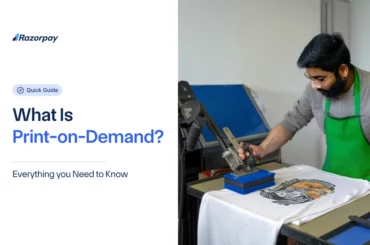Do you know that the term ‘marketing mix’ was first coined in 1953 by Neil Bordon, a Harvard Business School professor, during his presidential address to the American Marketing Association (AMA)?
Since then, the 4Ps of marketing have been used multiple times by numerous marketers worldwide to grow and accelerate their business through various channels and get a firm footing among consumer groups.
What Essentially is Marketing Mix?
The marketing mix is a collection of essential factors that a marketer can strategically use to influence the buyer’s decision to purchase their product or service.
Effective marketing involves focusing on multiple areas instead of concentrating only on a single message. It helps reach a wider audience and brainstorm effective strategies, which is especially useful for influencing customers’ buying decisions while launching new products and services or upgrading existing products. Let’s study the 4Ps of marketing that form an essential part of the marketing mix in the next section.
Related Read: What is a Niche Market? With Examples & Strategies
The 4Ps of marketing: An understanding
The 4Ps of marketing are like the ingredients in a recipe for a successful marketing strategy. The first P is product, which means the stuff you’re selling. The second P is price, which is how much you’re charging for the stuff. The third P is place, which is where people can get their hands on the stuff. And the fourth P is promotion, which is how you’re telling people about the stuff you’re selling. By using the 4Ps effectively, you can create a marketing mix that appeals to your target market and helps your business succeed.
What are the 4Ps of marketing?
The marketing mix comprises the 4Ps of marketing: Product, Price, Place, and Promotion. E. Jerome McCarthy first introduced them in the book ‘Basic Marketing: A Managerial Approach.’ The 4Ps of marketing allow luck out of the equation and provide a clear-cut way of building a successful launch and marketing strategy.
Let’s get a deeper understanding of each of them.
1. Product
Product, the first component of the 4Ps of marketing, is something that you can sell. It can be either a physical or intangible service specifically designed to satisfy the customer’s needs, wants, desires, and ambitions. Your product should have a USP that differentiates it from competing products and builds an emotional connection with your target segment.
The majority of the successful products are those which were first in their category. For example, Apple was the first brand to launch a smartphone that enabled users to peruse the internet, play music and make phone calls. There are no recent iPhone sales figures as Apple stopped releasing the public sales figures in November 2018. However, the total iPhone sales as of November 1, 2018, was $2.2 billion. The same year, the company also announced they were approaching selling 2 billion iOS devices.
The following questions will allow you to get a comprehensive understanding of the “Product” component and help decide what you are offering to your customers:
- What factors will encourage customers to purchase your product instead of your competitors? For example: Is it packaged beautifully, or is it the least expensive product in the market, or does it taste better than the rest?
- What problem will your product solve? For example: Are you improving upon an already existing antivirus security software, or have you developed a new virus detection algorithm that can identify new types of computer viruses?
- Is the user’s experience similar to what you are promising? For example, a TV advertisement promises that your company’s washing machine requires only 10 grams of washing powder to clean 10 clothes. Is the customer getting that benefit? If not, what is the degree of difference between the promised vs. actual benefit?
2. Price
Price, the second component of the 4Ps of marketing, refers to what the customer needs to pay to purchase your product. There is always a tug of war between what the seller wants to charge and what the buyer wants to pay. The actual price of the product is always a compromise between the two quantities.
The golden rule of pricing is to find that sweet spot where both the seller and the buyer are satisfied. But it would be best if you remembered a few things about the “Price” component.
If you charge less, you will sell a large volume of goods, but your profits will take a hit. On the other hand, if you charge more, you will sell only a small volume of goods, but your profits will increase.
Price is an essential factor that also helps in brand positioning and developing a positive customer perception. Remember that your customers might doubt the product quality if they are less expensive. However, they might have second thoughts about purchasing your product if the price is too high, especially if there are similar products in the market.
Ask yourself the following questions to keep the product price in check:
- What is the cost price of your product? This step will ensure that your selling price is always higher than the cost price not to make any losses.
- What is the demand for your products? Remember that the higher the demand, the higher the price you can charge.
- Do you belong to an industry where demanding higher markups is an accepted practice? For example, the wedding industry is well-known for charging higher markups.
- What are the prices of your competitor’s products? Are they more or less than yours?
UNIQLO is a clothing brand of global casual wear headquartered in Japan. In contrast to its competitors in the casual wear category, UNIQLO has low prices and creates daily-use garments. UNIQLO procures its fabric from its material manufacturer partners and can secure stable, high-quality materials at a low cost due to high-volume orders. This way, they can get high-quality and low-cost material.
3. Promotion
Having an excellent product and selling it at a competitive price is necessary but not sufficient. Promotion, the third component of the 4Ps of marketing, is an essential component of the marketing mix that consists of communication tactics that inform your target segment about your products.
The promotion has the following three components:
- The promotional message that is sent to the target audience.
- The target audience that receives the promotional message.
- The medium through which the promotional message is sent.
These questions will help you judge the “Promotion” component and build a better promotional strategy:
- What will the promotional message contain? The message should talk about the benefits that users will get by using your products and how it will help them solve their problems.
- Would you communicate through text, audio, or video?
- Which channel will you use to communicate your message — a full-page newspaper advertisement, short TV ads, podcasts, email newsletters, or mobile advertising?
- At which time of the year will the ads appear? Remember that seasons and festivals affect consumer purchases.
Businesses should focus on blending commerce and compassion. QuickBooks is the perfect example. They reallocated their pre-planned media time and spent it on an 80s-oriented campaign targeted at businesses that are the “backbone of the economy.”
Through the campaign, they applauded the grit and determination of such businesses. The commerce part was understated, although QuickBooks made it clear that their doors are open and available to provide support.
4. Place
Place, the fourth component of the 4Ps of marketing, refers to where consumers can purchase your products. It can be a brick-and-mortar shop or an online portal. In this step, marketers need to select the best distribution channel to decide how fast consumers will get your products.
The following questions will provide you a blueprint on the critical areas you must focus on while deciding the “Place” component.
- Through what channels will the customer find the products you are selling?
- Through which channel you will sell your products — physical shops or online stores?
- How will you design the supply chain — will you sell directly to consumers, or will there be a mediator?
- Will, you sell your products exclusively on your company’s website or through third-party online marketplaces like Amazon and Flipkart?
In some cases, placement may also refer to including a product in movies, tv shows, documentaries, or web pages. For example, the 1995 movie GoldenEye, the seventeenth in the James Bond series, was the first movie not to feature an Aston Martin car.
Instead, they introduced a Z3 by BMW. Although the Z3 was not launched until after the movie had been removed from the theatres, BMW received 9000 orders for the car just a month after the movie release.
How to include the 4Ps into your marketing plan
Including the 4Ps in your marketing plan is like following a recipe for success. First, think about the product or service you’re selling and make sure it’s something people want. Then, set a price that’s fair for both you and your customers. Next, figure out where and how you’re going to sell your product or service – online, in-store, or both? Finally, promote your product or service through advertising, social media, and other channels that your target market uses. Make sure your messaging is consistent and resonates with your audience.
Exactly when did the 4Ps become the 7Ps?
The 4Ps of marketing have been around for ages, but in the 80s, some marketing experts decided to add a few more Ps to the mix to make it even more comprehensive. So, they added people, process, and physical evidence, creating the 7Ps of marketing.
So, what do these additional Ps mean? Well, people refers to the staff and employees involved in delivering the product or service, and their level of expertise and customer service skills. Process refers to the procedures and systems used to deliver the product or service, and how efficient and effective they are. And physical evidence refers to the tangible elements of the product or service, such as packaging, branding, and the physical environment in which the product or service is delivered.
The 7Ps provide a more holistic approach to marketing.
What are a few examples of the 4Ps of marketing?
Here are some examples of the 4Ps of marketing:
- Product: A smartphone with a large screen, long battery life, and advanced camera features.
- Price: A luxury car priced higher than its competitors due to its superior quality and brand image.
- Place: A popular restaurant located in a busy shopping district with ample parking and easy access.
- Promotion: A clothing brand running a social media ad campaign featuring influencers wearing its latest collection.
Conclusion
Remember that understanding the marketing mix concept is one thing but implementing it requires an entirely different skill set. So, think about the 4Ps of marketing in response to your challenges, customer preferences, and the existing market conditions. Apply the marketing mix principles to brainstorm effective strategies for your business and stand out from your competitors.
Frequently asked questions (FAQ)
1. How Are the 4Ps of Marketing Used?
The 4Ps of marketing (Product, Price, Place, Promotion) are used to develop effective marketing strategies by focusing on product development, pricing, distribution channels, and promotional activities to meet customer needs and achieve business objectives.
2. Are the marketing 4Ps still useful?
Yes, the marketing 4Ps (Product, Price, Place, Promotion) are still useful as they provide a framework for developing effective marketing strategies. However, they need to be adapted to the changing consumer landscape and digital advancements.




![GST State Code List & Jurisdiction 2025 [Updated List] GST State Codes](https://d6xcmfyh68wv8.cloudfront.net/learn-content/uploads/2024/02/GST-State-Codes-370x245.webp)
